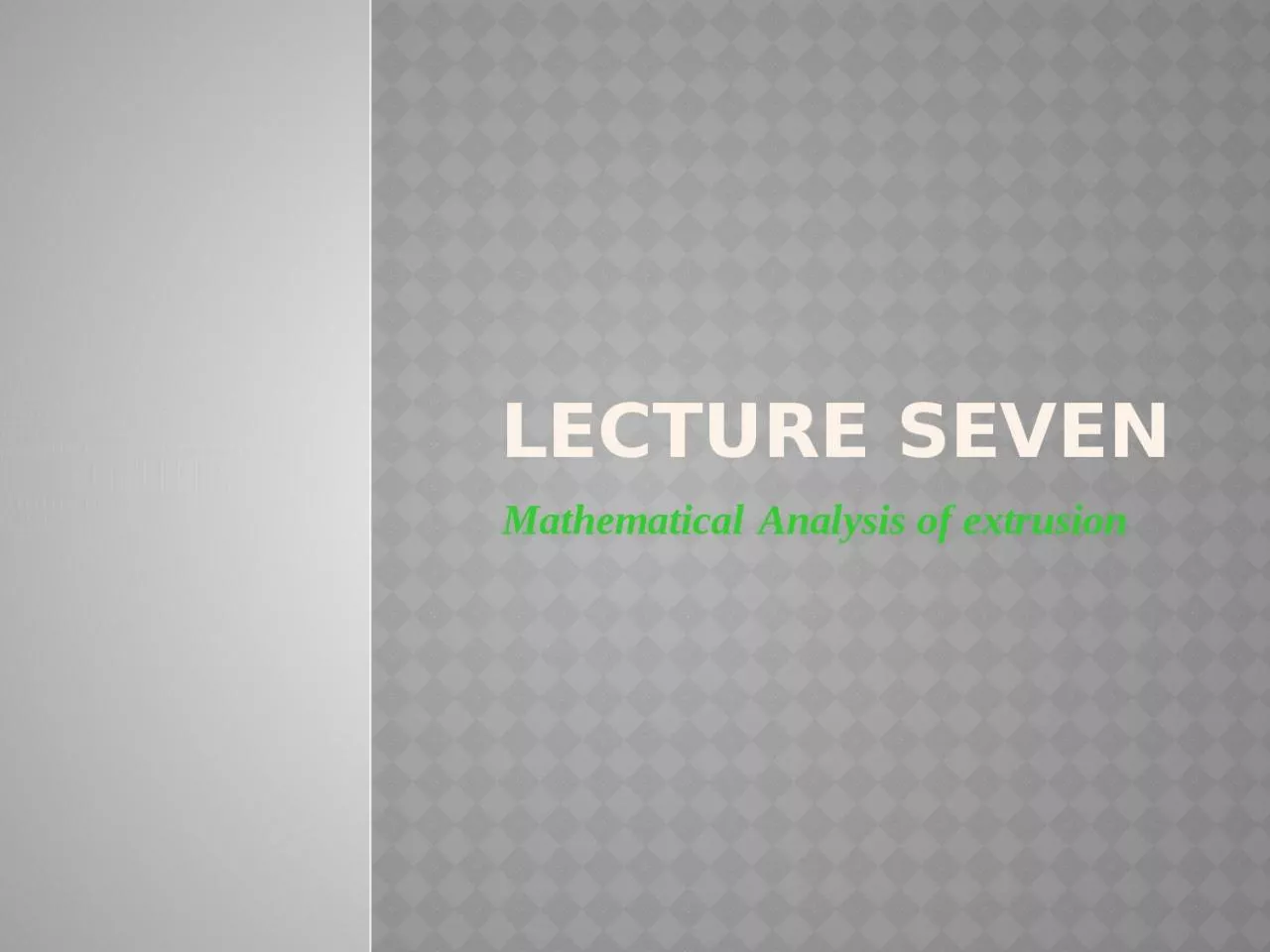

Analysis of extrusion ANALYSIS OF EXTRUSION Let us use Figure 71 as a reference in discussing some of the parameters in extrusion The diagram assumes that both billet and extrudate are round in cross section One important parameter is the ID: 1022315
Download Presentation The PPT/PDF document "Lecture seven Mathematical" is the property of its rightful owner. Permission is granted to download and print the materials on this web site for personal, non-commercial use only, and to display it on your personal computer provided you do not modify the materials and that you retain all copyright notices contained in the materials. By downloading content from our website, you accept the terms of this agreement.
1. Lecture seven Mathematical Analysis of extrusion
2. ANALYSIS OF EXTRUSIONLet us use Figure 7.1 as a reference in discussing some of the parameters in extrusion. The diagram assumes that both billet and extrudate are round in cross section. One important parameter is the extrusion ratio, also called the reduction ratio. The ratio is defined: 7-1Where rx= extrusion ratio; Ao= cross-sectional area of the starting billet, mm2 (in2); and Af = final cross-sectional area of the extruded section, mm2 (in2). The ratio applies for both direct and indirect extrusion the value of rx can be used to determine true strain in extrusion, given that ideal deformation occurs with no friction and no redundant work: 7-2Under the assumption of ideal deformation (no friction and no redundant work), the pressure applied by the ram to compress the billet through the die opening depicted in our figure can be computed as follows: 7-3Where = average flow stress during deformation, MPa (lb/in2)
3. ANALYSIS OF EXTRUSIONFigure (7.1) Pressure and other variables in direct extrusion.
4. Friction exists between the die and the work as the billet squeezes down and passes through the die opening. In direct extrusion, friction also exists between the container wall and the billet surface. The following empirical equation proposed by Johnson for estimating extrusion strain (in friction condition): 7-4Where εx = extrusion strain; and a and b are empirical constants for a given die angle. Typical values of these constants are: a = 0.8 and b = 1.2 to 1.5. Values of a and b tend to increase with increasing die angle.Indirect extrusion the ram pressure to perform can be estimated based on Johnson’s extrusion strain formula as follows: 7-5Where is calculated based on ideal strain from Eq. (7-2), rather than extrusion strain in Eq. (7-4).In direct extrusion, the effect of friction between the container walls and the billet causes the ram pressure to be greater than for indirect extrusion, the following formula can be used to compute ram pressure in direct extrusion: 7 -6
5. Where the term 2L/Do accounts for the additional pressure due to friction at the container– billet interface. L is the portion of the billet length remaining to be extruded, and Do is the original diameter of the billet. Note that p is reduced as the remaining billet length decreases during the process. Ram force in indirect or direct extrusion is simply pressure p from Eqs. (7-5) or (7-6), respectively, multiplied by billet area Ao : 7.7Where F = ram force in extrusion, N (lb).
6. Example: A billet 75mmlong and 25mmin diameter is to be extruded in a direct extrusion operation with extrusion ratio rx = 4.0. The extrudate has a round cross section. The die angle (half angle) = 90◦ The work metal has a strength coefficient = 415 MPa, and strain-hardening exponent = 0.18. Use the Johnson formula with a = 0.8 and b = 1.5 to estimate extrusion strain. Determine the pressure applied to the end of the billet as the ram moves forward. Sol.:Let us examine the ram pressure at billet lengths of L= 75mm (starting value),L= 50 mm, L= 25 mm, and L= 0.We compute the ideal true strain, extrusion strain usingJohnson’s formula and average flow stress:L=75mm,With a die angle of 90◦, the billet metal is assumed to be forced through the die opening almost immediately; thus, our calculation assumes that maximum pressure is reached at the billet length of 75mm. For die angles less than 90◦, the pressure would build to a maximum as the starting billet is squeezed into the cone-shaped portion of the extrusion die.
7. L=0, Zero length is a hypothetical value in direct extrusion. In reality, it is impossible to squeeze all of the metal through the die opening. Instead, a portion of the billet (the ‘‘butt’’) remains unextruded and the pressure begins to increase rapidly as L approaches zero.